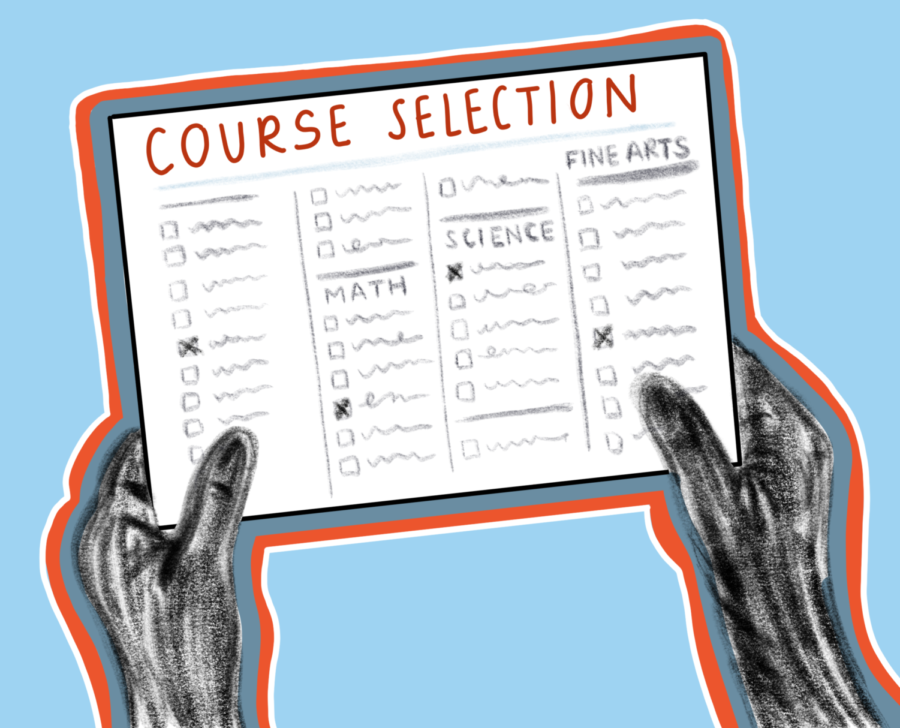Students reflect on course selection process
Six months feels like a long time to do anything. And when it comes to course requests, it can feel especially strange to choose the courses for the following year when the second semester has barely begun. But, looking more closely, the process of arranging every single class for all 3,600 of ETHS’ students while balancing students’ wishes, classroom capacities and course availability appears to be an impossible feat. Many students are unaware of the intricacies of this process once they get past their counselor meetings, however, it has huge effects on all of our lives.
“I personally never see the complexity. We just kind of experience all the ramifications of it, like having to choose our classes in January, about halfway through the year. And when you really don’t know what you will or won’t get it sort of feels like a lottery. Then you find out in August if you got your third choice, or in my case getting a class that you didn’t sign up for at all,” junior Margo Anderson says.
For some, the decisions can feel uninformed because for year long courses only half of the material has been explored, and for second semester only classes content has barely begun by the time decisions are needed.
“I don’t really know what I’m interested in so early in the year. I don’t know what I want to pursue after taking my [current] classes, because some classes can be on easier topics [first semester] but the next quarter will be harder,” sophomore Tyler Tang says.
ETHS’s schedule planning is, in large part, mechanical. As counselor Stephen Lucas explains, the school utilizes programs that are able to organize all of the different information input by counselors and arrange classes in order to maximize the chances of students getting the courses they want. This doesn’t mean that everyone can get everything they ask for though; it’s a utilitarian system, prioritizing as many people having as many results with which they would be happy as possible. The course requests students make can provide definitive information when it comes to what classes will be in demand the next year, so it’s important that it’s worked out early on. Lucas explains the way counselors can try to combat the fears students have about making decisions so early.
“We try to balance out information that we do have [in] terms [of] grades, plus how students are feeling about the school year with what they think, at this point in their lives, their goals are for high school and try to match all of that up with the graduation requirements, general post-secondary plant planning, and trying to have conversations about balancing social-emotional health. So it’s a lot of different factors. And we really just try to get students to pause and think about all of it,” Lucas says.
But with decisions about courses happening so early, a student realizing that they have made a mistake is not at all unordinary. Junior Sachin Clark experienced this at the beginning of the 2021-2022 school year when he switched from AB to BC calculus. Although he originally opted for AB, the easier course, once the year actually started Clark realized that the class simply wasn’t the right fit for him.
“I just remember hearing that BC was a really challenging class and [at the time], coming from e-learning, I didn’t feel like I had the necessary skills to go from Pre-Calculus to an extremely hard math class,” Clark says. “So I was in AB, and I liked my class and my teacher and the students a lot, but I just wasn’t finding the content too challenging. I tried waiting it out, because it was in the first couple of weeks that I was thinking about transferring. But [AB] was still not [hard enough] for me.”
In some ways, counselors’ role in helping students drop courses is just as important as their part in the initial schedule formulation. It can be a challenging process to facilitate and often requires a lot of communication between various teachers, administrators, and of course, the student. However, the swiftness and efficiency of the process has been shocking to students who’ve had to go through it.
“[Dropping a course] was extremely smooth. I reached out to my teacher first, and she gave me a very compelling, very kind, pressure-free speech about why she would want me to stay in my class in her class. And then, after that, I ended up reaching out to my counselor, and I had a meeting with him. That was on Monday. And today, three days later, I’m already switched to the other class,” Anderson says.
Lucas explains that this is true for most instances of dropping a class, especially if it’s not a requirement.
“Dropping a class can be pretty straightforward, especially if it’s an elective class, and I’m looking at electives as any class that’s not required for graduation. As long as a student would still have six credits, they can drop an elective class; that process is usually pretty straightforward. The process begins with a conversation about why the student wants to drop the class and how the student would want to use that time as a study hall or unscheduled period. We would also want to consider if there would be an impact on the student’s path to graduation or post-secondary goals. There are many circumstances when dropping an elective is a good decision for a student,” Lucas says.
However, the process of transferring into a class is often not as simple. It requires a lot more planning and maneuvering and sometimes simply cannot be done.
“The other thing that you’re talking about, a course change or a level change, gets a lot trickier. In part, it actually goes back to the course request process, because one of the things that’s a really important piece in [whether you can switch into a class] is how many classes we offer, how many times a class is offered and how many teachers we have for certain classes. Unfortunately, we just can’t accommodate students changing their minds about classes.” Lucas says.
But despite all of these difficulties, the most important thing throughout the whole process is students’ wellbeing. Although it can be extraordinarily challenging, and often there’s never something one individual person can do, Lucas explains that, after e-learning, students have appeared more receptive to prioritizing their mental health.
“I had more students who I think would have considered taking more AP classes [if COVID hadn’t happened] but were more willing to say, ‘Hey if I’m taking AP Psych or AP science, maybe I don’t need to take other APs,’” Lucas says. “So I think students were a little bit more open to those conversations than in the past, and I’d say I had more students bring up the fact that they thought a lot about how many honors and AP level classes they want to take next year. I think students were more open to these conversations, because this year has been such a big adjustment for everyone.”
Your donation will support the student journalists of the Evanstonian. We are planning a big trip to the Journalism Educators Association conference in Nashville in November 2025, and any support will go towards making that trip a reality. Contributions will appear as a charge from SNOSite. Donations are NOT tax-deductible.





